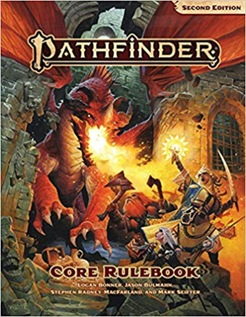One of the issues that I (and many others) had during the Pathfinder 2 playtest was that wizards had been reduced in power to the level of ineffectiveness. I’m interested in how things have changed since the playtest, and so I bring you a selection of first-level Wizard spells, with notes on how they were changed from the playtest.
With these spells, I’m looking for combat spells: spells that affect battle and can win battles that otherwise would be lost. That’s the traditional role of the Wizard in Dungeons & Dragons. D&D 5E brought it off brilliantly: first-level Wizard spells have a real effect on the battlefield. How does PF2 fare?
Note that a fighter is likely to be attacking two times a round, dealing 1d8+4 each time they hit. The second attack has a -5 penalty. My assumption is that they’ll hit twice a significant amount. (Against a goblin, a Fighter with an 18 strength and trained in longsword will hit 55% of the time with their first attack and 30% of the time with their second attack – average damage of 8 per round). Those two attacks take two actions, which is also the number of actions needed to cast most Wizard spells. And that’s the weak case – assuming just a longsword! A raging fury barbarian does 1d12+10 damage with a greatsword! (There’s no limit to how many battles in which the barbarian can rage, either).
Burning Hands. 2d6 damage to each creature in a 15-foot cone; save for half damage. Assuming 2 creatures in the cone, with a 50% chance of saving, that’s an average of (total) 10.5 damage. The spell gets significantly better if you can use it on a clump of targets. This spell has not changed since the playtest. Note: When prepared with a higher-level slot, it gets +2d6 damage per extra level.
Color Spray. Each creature in a 15-foot cone is stunned 1, blinded for 1 round, and dazzled for 1 minute. Saving reduces this to dazzled for a round. What do all these things mean?
- Stunned 1 – the creature loses one action (of three on their turn).
- Blinded 1 round – the creature has a 50% chance of missing when attacking and has a -2 to AC
- Dazzled 1 minute – the creature has trouble seeing and has a 25% miss chance on all targets
The playtest version didn’t include Stunned 1.
Goblin Pox. One creature you touch must make a Fort save or become Sickened 1. (and each day might get more ill!). On a successful save, they’re still sickened 1.
- Sickened 1 – You have a -1 penalty to all your checks and DCs.
Grim Tendrils. Each creature in a 30-foot line takes 2d4 negative damage and 1 bleed damage. On a Fort save, they reduce this to half damage (and no bleed). No changes from playtest. (Assuming 3 targets, average about 11 damage plus bleed).
Magic Missile. For each action you spend when casting the spell (up to 3), you create one missile that hits automatically and deals 1d4+1 damage. No changes from playtest. (Average 10.5 damage).
Shocking Grasp. If you successfully hit the target, you deal 2d12 electrical damage; if the target has metal armour you get +1 to hit and the target takes 1d4 persistent damage. Was 1d12+ability modifier in playtest. (Average 6.5 damage).
Sleep. Not a combat spell. Seriously – they wake up on their next turn unless you’re REALLY quiet. This does not describe combat.
So, of the first-level Wizard spells, there’s not that much that is seriously exciting. Color Spray is a spell of great interest – it makes life very tough for the monsters. Burning Hands is… sort of okay?
Looking at the hit points of typical low-level monsters – Giant Rat (8), Goblin (6), Hobgoblin (20), Kobold (8), Ogre (50), Orc (15), Skeleton (4), Wolf (24), Zombie (20).
Comparatively, you have the high-impact Dungeons & Dragons 5E first-level wizard spells:
Thunderwave – 2d8 damage plus push back (save half) in a 15-ft. cube.
Sleep – 5d8 hp of creatures fall asleep (until awakened by an action or damage)
Burning Hands – 3d6 damage (save half) in a 15-ft. cone.
Hideous Laughter – target falls prone and is incapacitated until it saves (additional saves on taking damage)
Magic Missile – 3d4+3 damage, autohit (the one spell that’s really similar!)
Ice Knife – Target takes 1d10 damage on hit; then it and adjacent creatures take 2d6 damage (save half)
Low-level monster hp in 5e: Giant Rat (7), Goblin (7), Hobgoblin (11), Kobold (5), Ogre (59), Orc (15), Skeleton (13), Wolf (11), Zombie (22)
A first-level fighter likely does 1d8+5 damage a round, if they hit – typically hitting is easier than Pathfinder, so an average of about 6-7 damage a round seems likely.
The Pathfinder 2 and D&D 5E spells look somewhat similar, but the PF2 spells seem generally to be less effective – and against a backdrop of the fighters being a LOT more effective, and the Wizards being less versatile. They’ve got to prepare their exact spells (Vancian casting) unlike the looser slot system of 5E. Honestly, I’m worried about the effectiveness of Wizards in PF2. With luck, they’ll play a lot better than they read, but I’m not thrilled by what I see. (There are other things about PF2 that thrill me!)


Personally, I just gave all casters 5e style casting. It works fine and gives them needed versatility since power is somewhat low early on.